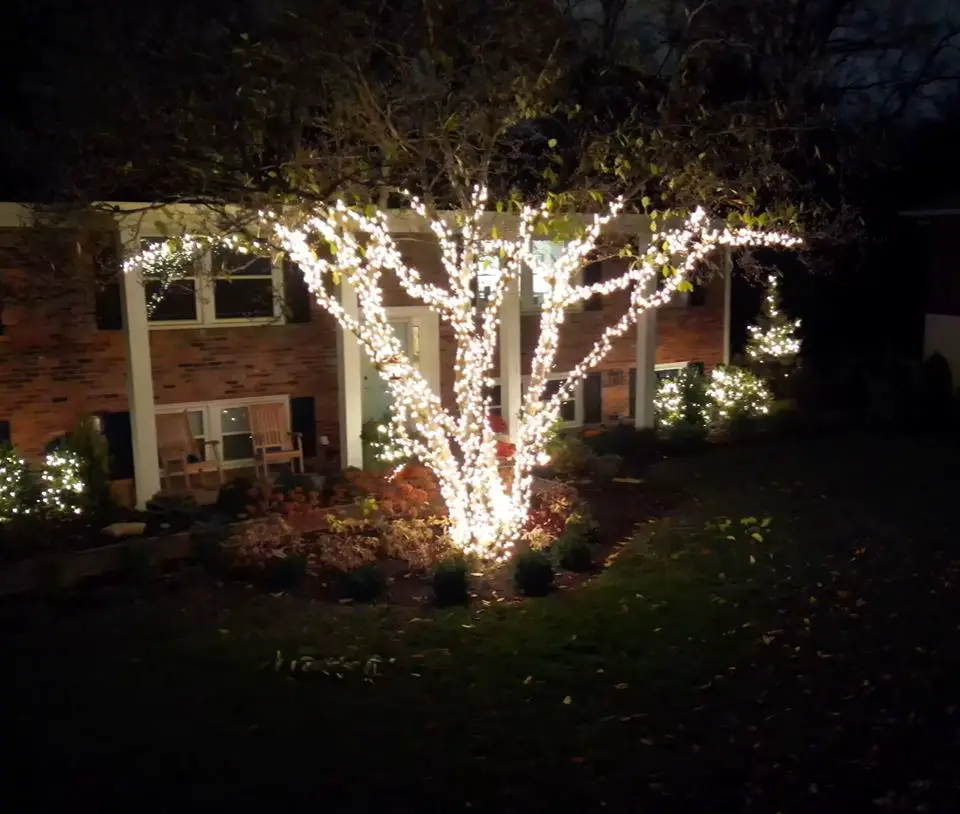With Christmas just around the corner, I thought it would be the perfect time to share some of my top tips and tricks for creating a nice-looking outdoor Christmas landscape lighting display. My favorite part: I’ll tell you how to make it easy install AND put away – year after year.
As a serial learner of lessons the hard way, I thought I would save you some time and show you exactly how the pros do it. Here’s a quick summary of the tips. You can click each one to jump down to it.
- Plan out what you want the lights to look like on paper
- Get high quality lights that you don’t have to throw away each year
- Get really good, long extension cords
- Test all the lights before putting them up (this was learned the hard way)
- Add multiple layers to provide depth
- Make sure there isn’t a tripping hazard
- Use a timer
I made a Youtube video highlighting exactly what tips I use to set up my Christmas lights.
My Ultimate Outdoor Christmas Light Secrets: Exposed
You know how your mom has that old recipe book with different meatloaf and weird Jell-O casseroles? This is basically the same thing but with old secrets from my experience. Some say that these secrets were originally found with the Declaration of Independence.
Tip #1: Map out the lights
The key to a successful outdoor lighting display is careful planning. Start by taking a stroll around your property and envisioning where you want to place lights. Consider highlighting architectural features like roof lines, trees, and porch columns. Planning ahead will help you determine the quantity and types of lights you need, preventing last-minute trips to the store and ensuring you have everything on hand when you start decorating.
Tip #2: Get the nice lights
When it comes to outdoor lighting, quality matters. I know it seems like buying more expensive lights is a huge waste of money, but it makes a huge difference in the installation experience.
Invest in durable, weather-resistant lights that can withstand the winter elements. LED lights are an excellent choice for their energy efficiency and long lifespan. They might cost a bit more upfront, but they’ll save you money in the long run and reduce the likelihood of mid-season replacements. Plus, they come in a variety of colors and styles, allowing you to get creative with your display.
Tip #3: Always keep in mind extension cord placement for Christmas lights
Dealing with a web of extension cords can be a headache. To minimize frustration, plan your layout with extension cords in mind. This is arguably the most important component of setting up the lights – matching the male plugs to the female outlets.
Use outdoor-rated extension cords and strategically place them to ensure a clean and organized setup. Consider using cord management tools like stakes or clips to keep everything in place and prevent tripping hazards. A well-thought-out extension cord strategy will save you time and make your display look polished.
Tip #4: Plug the Christmas lights in before hanging them up
There’s nothing worse than spending hours meticulously placing lights, only to discover a section isn’t working. Before you start hanging lights, test each strand to ensure they are functioning correctly.
This will save you the headache of troubleshooting later on and help you identify any faulty bulbs that need replacing. It’s a small step that can make a big difference in the overall success of your outdoor lighting project.
Nothing worse than getting the lights up, gathering everyone around, and having a strand be completely dead.
Tip #5: Use multiple layers of Christmas lights
To create a visually stunning display that will make your neighbor jealous, think about adding depth through layered lighting. Use a combination of different light types, such as string lights, pathway lights, and spotlights. This will add dimension to your outdoor space and make it more visually appealing. Experiment with different angles and distances to find the perfect balance. Layered lighting not only enhances the overall aesthetics but also adds a touch of swag to your Christmas display.
Tip #6: Please be safe
While the goal is to create a dazzling display, safety should always be a top priority. Secure lights properly to avoid them falling or becoming a tripping hazard. Be cautious when using ladders, especially on uneven ground.
If you’re unsure about the safety of a particular setup, don’t hesitate to ask your jealous neighbor for help. Ensuring a safe decorating environment will allow you to enjoy your Christmas lights without any worry.
Tip #7: Use a timer for your Christmas lights
Save yourself the trouble of manually turning lights on and off every day by using timers. Timers are a game-changer, automating the process and ensuring your display shines bright during the designated hours. Set them to come on just as the sun sets and turn off when you head to bed. Not only does this make your life easier, but it also contributes to energy conservation by avoiding unnecessary use during daylight hours.
Best of luck hanging up Christmas lights!
Wrapping up, I hope these tips help you create a hassle-free and stunning outdoor lighting display this Christmas season. Remember, the key is to plan ahead, invest in quality, and prioritize safety. Stay tuned for more helpful tips, and don’t forget to subscribe for a chance to win exciting giveaways every month. Until next time, happy decorating!
Here’s my secret: You can use Christmas lights on your bushes and cover with a sheet to protect bushes from frost.
